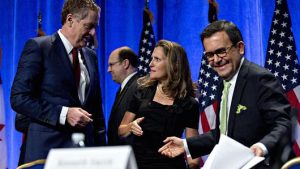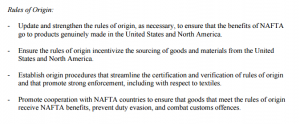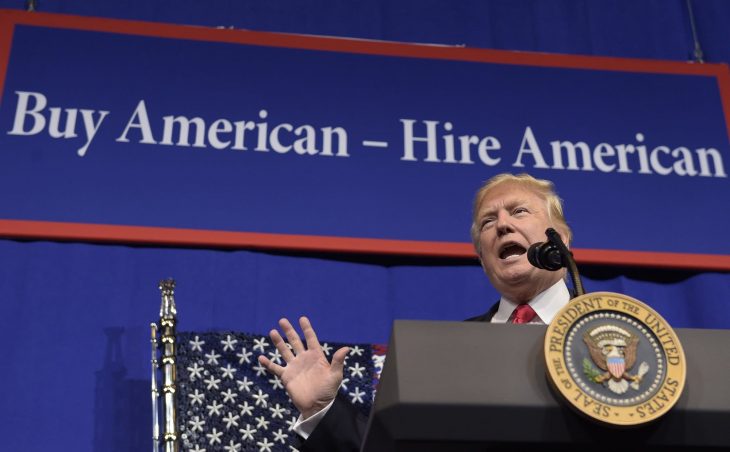Negotiators from the U.S., Canada and Mexico convene this week to begin hashing out changes to the North American Free Trade Agreement.
While the two U.S. trading partners have said they welcome the negotiations, the outcomes are far from clear. The Trump administration’s unshakable focus on reducing America’s trade deficits, and the president’s repeated threats to dissolve the deal altogether, could exacerbate the already-strained relationship among the three nations.
Much of the buzz leading up to Wednesday’s kickoff has centered around so-called “rules of origin,” which ensure that products from non-NAFTA countries don’t receive the same benefits as goods produced by NAFTA members.
Without rules of origin, non-member countries can skirt around tariffs and other trade barriers by exporting goods through the lowest-tariff member country and into the other member nations. To avoid this form of arbitrage, origin rules establish that at least a fraction of goods covered by a free trade agreement have to be produced within the NAFTA region.
Among the administration’s goals is to “update and strengthen the rules of origin, as necessary, to ensure that the benefits of NAFTA go to products genuinely made in the United States and North America.”
Adjusting rules of origin holds particular significance for the auto industry. Currently, 62.5 percent of a vehicle’s content must be made within the NAFTA region to avoid tariffs — a higher proportion than any other trade deal, according to Mitch Bainwol, president of the Alliance of Automobile Manufacturers.

Some experts have questioned the language of the administration’s objective.
“I don’t know what they mean by ‘strengthen.’ And I don’t know why it’s the Trump administration,” said Richard Cooper, economics professor at Harvard University. He explained that U.S. tariffs on autos, at 2.5 percent, are the lowest of the three NAFTA members.
The distinction made between “the United States and North America” also raised concerns about rules of origin negotiations.
“I think there’s been some confusion among people in the Trump administration on what exactly they are,” said Caroline Freund, senior fellow at the Peterson Institute for International Economics.
“They seem to assume that they’re U.S. content requirements, which they’re not. They’re regional content requirements,” Freund said. “It’s difficult to imagine how increasing rules of origin would lead to more U.S. content in trade with our NAFTA partners.”

Pursuing stronger rules of origin, either as a way to attack the trade deficit or to protect American producers, could raise costs, Freund said. If American companies are buying auto parts and components from other countries, it’s safe to assume that an artificial barrier to trade would increase the costs of those parts.
And despite the Trump administration’s words and actions combating burdensome regulations, rules of origin are themselves a form of business regulation — and a complex one at that. Different product classes adhere to different rules of origin, and often-tortuous supply chains can multiply the effects of tariffs and make products difficult to keep track of.
A request to the U.S. Trade Representative’s office for comment wasn’t immediately returned.
The first round of negotiations, set to begin on Wednesday, will likely focus on “Chapter 19” rules for settling disputes between NAFTA members. Canada matched the Trump administration’s threats on Monday, suggesting it could walk away from the whole trade agreement if the U.S. tries to remove the rules.
A U.S. Trade Representative official said “we are actually going to be quite ambitious in this first round,” Reuters reported. Indeed, a U.S. renegotiation summary released in July contains well over 100 proposals for changing the 23-year-old trade deal.
The large volume of proposals, however, belies uncertainty at the heart of the discussions.
During the 2016 presidential campaign, President Donald Trump repeatedly threatened to pull the U.S. out of NAFTA. In April, reports surfaced that the president was considering an executive order that would begin withdrawing the U.S. from the trade deal entirely. After receiving calls from Canada and Mexico and public statements against the plan from U.S. politicians, including at least five prominent Republicans, Trump reconsidered.
“I received calls from the President of Mexico and the Prime Minister of Canada asking to renegotiate NAFTA rather than terminate. I agreed,” he tweeted at the time, “subject to the fact that if we do not reach a fair deal for all, we will then terminate NAFTA. Relationships are good-deal very possible!”
But the “fair deal for all” appears to require taking measures to lower the U.S. trade deficit with Canada and Mexico. The first of the 117 objectives listed in the renegotiation summary is to “improve the U.S. trade balance and reduce the trade deficit with the NAFTA countries.”
Negotiating down Canada and Mexico’s trade surpluses with the U.S. could be damaging to NAFTA, Harvard’s Cooper said, because it will require tense negotiations about the amounts of different goods that the U.S. buys from those nations.
“If the negotiators sit down with that as a primary objective,” Cooper said, “this is going to be a very difficult negotiation.”
Source: CNBC



